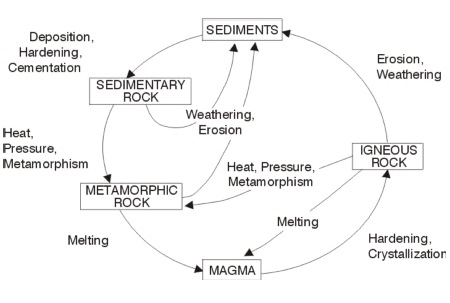|
Background
When we think of what makes up our Earth, the first thing that comes to mind is rocks. When we hike in the mountains, walk along a river bed, or sit on a beach, we constantly observe the rocks in our environment. Without realizing it, we automatically classify these rocks in our minds by observing particular features.
Rocks are made up of minerals but they are not minerals themselves. Rocks usually have more than one mineral within them. The way that mineral grains are arranged in rocks are a good clue to their identifications. Rocks are grouped into three main types based on their origin. These are igneous, sedimentary, and metamorphic. The characteristics that we observe most easily in rocks, particularly the arrangement of mineral grains, helps us classify them according to these categories.
The ROCK CYCLE refers to how rocks are constantly being recycled in much the same way as our garbage and waste. When rocks break down due to erosion, the tiny pieces are carried off and eventually buried again. If they are buried deeply enough, they will melt into magma and will eventually be reborn as igneous rock. The rock cycle is illustrated below, and is an essential part of understanding rock classification and identification.
The Rock Cycle

Next 
|